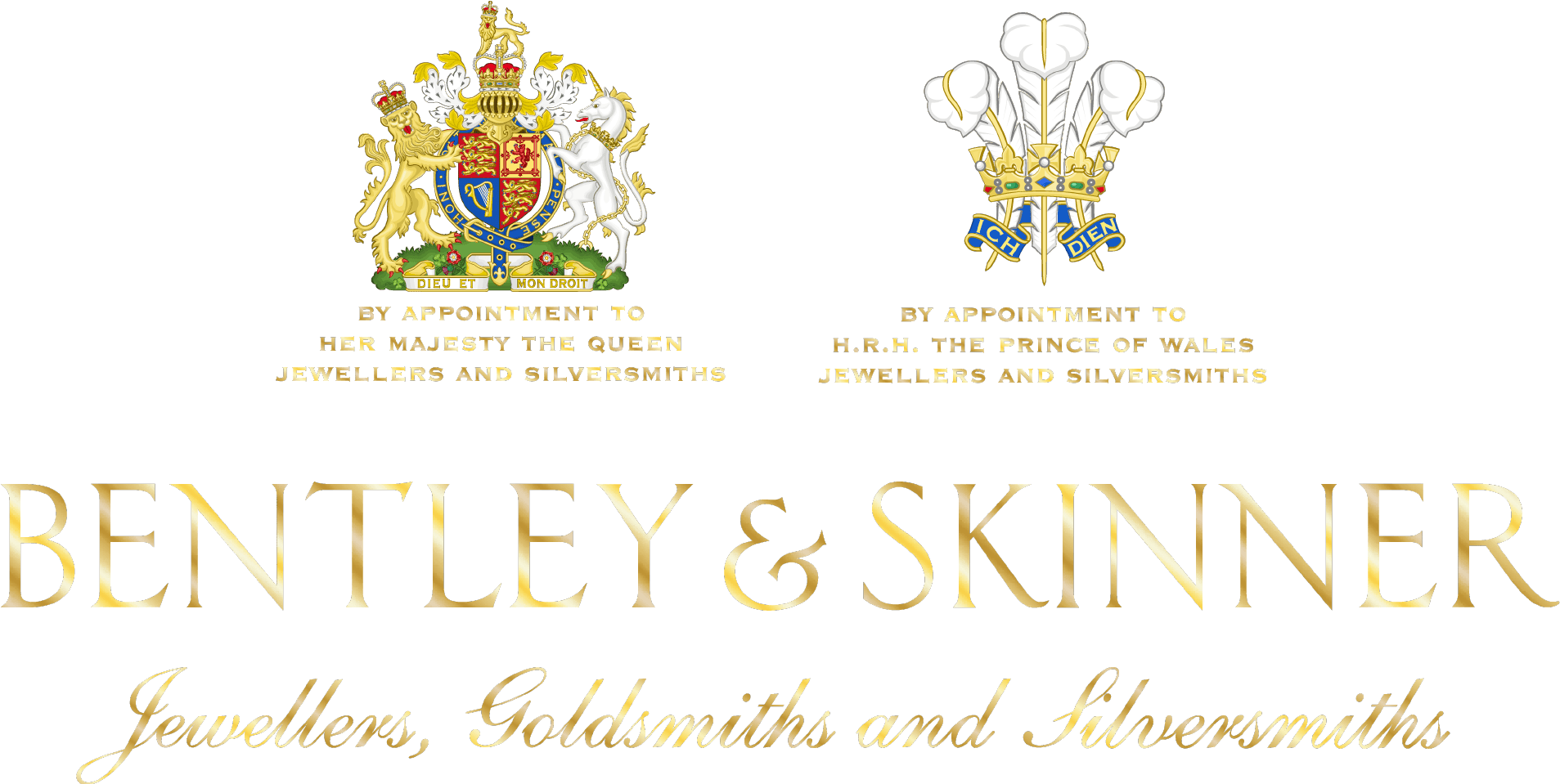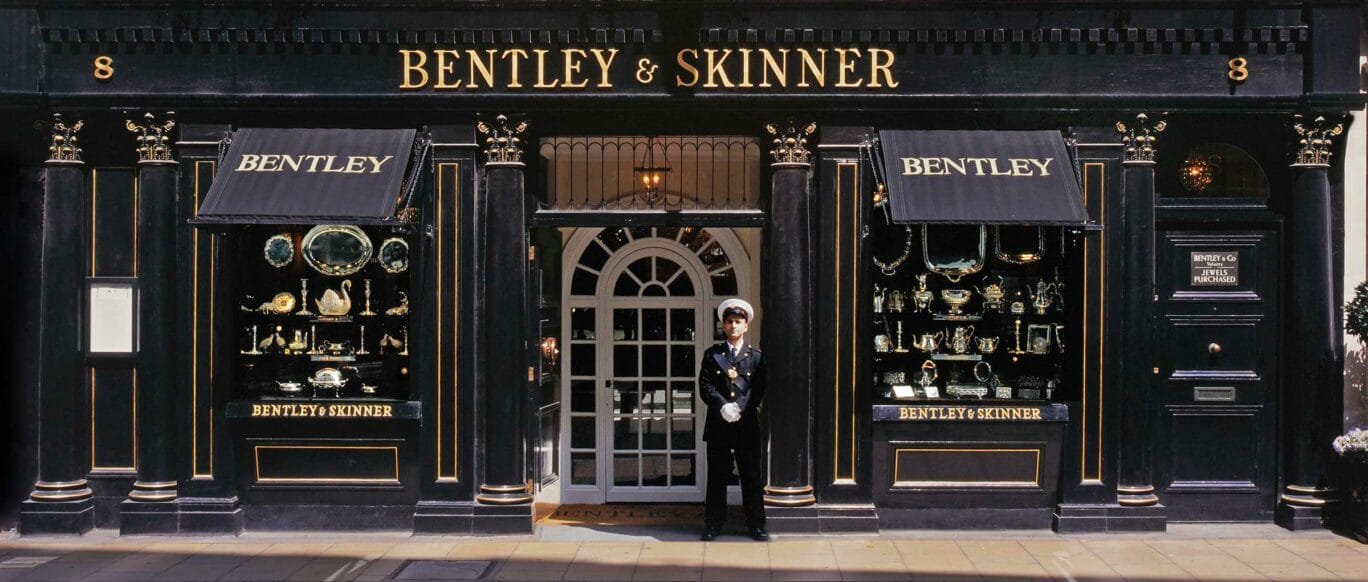


Loading...

About Us
Mayfair is legendary: for precious jewels, antiques and works of art, fashion and the accessories of gracious living, its shops are unsurpassed anywhere in the world.
Bentley & Co was first established in Bond Street in 1934. For over 50 years the company was under the sole direction of the present Director’s late uncle John Sheldon, a connoisseur of Russian descent whose magnificent collection of jewels created world-wide interest when sold through Sotheby’s in 1985.
Skinner & Co was established in 1881 and had been in the same family for three generations. The Company was first invited to supply jewellery to the Royal Family in the latter years of Queen Victoria’s reign.
Bentley & Skinner, Jewellers by Royal appointment to Her Late Majesty The Queen and His Former Royal Highness The Prince of Wales, now His Majesty King Charles III, buy and sell the loveliest jewellery.
In September 2010 Bentley & Skinner relocated to splendid new premises at 55 Piccadilly, from where they continue in the tradition that has helped to make Mayfair a synonym for all that is excellent in the civilised world.
Specialising in fine antique jewels, Faberge and silver, Bentley & Skinner is renowned for its unparalleled collection of engagement rings, diamond tiaras and the classic Bentley & Skinner Signet Ring. Often called the “Family Jewellers” the company has always been known as the best place to sell or exchange jewellery.
The repair and re-modelling of jewellery is undertaken with the greatest care and attention to detail by expert craftsmen on their premises.
The company is also at the forefront of modern jewellery design and innovative goldsmithing techniques, responsible for such unique works as the Damien Hirst diamond skull, For The Love Of God.
Bentley & Skinner strictly observe recognised policies regarding environmental sustainability and fair trade.
As a family concern still run by its Managing Director Mr Mark Evans, personal service has always been Bentley & Skinner’s hallmark and every enquiry is treated with courtesy and the utmost discretion.
More than one hundred and fifty years ago Ilya Schlounde set up in business as a jeweller in Vilna (now Vilnius), Lithuania, where he and his Russian wife, Sarah (nee Reich), had two children, Leon, born in 1864, and two years later, Bertha. Leon, a bright determined young man, moved to Moscow where he espoused the radical cause. As an active member of the Social Democratic party he became friendly with both Lenin and Rosa Luxembourg, but these activities, like those of many contemporaries, aroused the suspicion of the authorities and he was briefly detained on a political charge.
To finish his education Leon Schlounde went to Paris where he studied analytical chemistry at the Sorbonne. Here he became an intimate of Marie Curie who sometime afterwards presented him with a highly unusual keepsake of her celebrated experiments of 1902: a lead box containing a minute sample of radium. Sadly it was lost during the Second World War when his daughter’s home in London was destroyed in a bombing raid. While Leon was working on dyes in Alsace he met Juliet, daughter of department store owner Abraham Lipman, a native of Cracow and married her in 1899.
Meanwhile in England the firm of A E Skinner & Co. was founded in 1881 by Alfred Ernest Skinner, who had trained with messrs Catchpole and Williams, the well-known firm of London jewellers. One of the most important commissions was the Devonshire diamond tiara in 1893. In the late 1890s Alfred Skinner was summoned to the palace to show jewellery to Queen Victoria and subsequently received his first Royal Appointment to King Edward VII . Excepting King George VI, A E Skinner & Co. continued to hold the Royal Warrant without interruption until it merged with Bentley & Co. in 1998.
Swipe to view more images
Leon and Juliet’s son Johann (later known as John, director of Bentley & Co.) was born at Mulhausen on 24th October, 1902. Leon was then employed as a metallurgist by the Viennese based Ashanti Gold Fields Corporation in the Gold Coast, subsequently in South Africa where he became a friend of Barney Barnato the diamond magnate, and later in the Lena Gold Fields in Siberia. It was from the South African gold mines that Leon was to send quantities of pitchblende to Marie Curie from which she first extracted radium.
Owing to increasingly painful arthritis Leon decided to remove to London where in 1905 he commenced trading in an office at 32 & 34 Clerkenwell Road under the style of Leon Schlund & Co., otherwise known as the London Refining & Metallurgical Works, mining engineers, analytical and consulting chemists, assayers and gold and silver refiners, telegraphic address ‘Zolotonius’. Leon, who entered a mark at Goldsmiths’ Hall in 1911, perhaps for the purpose of importing gold or silver wares, is recorded in the same year at his private address, 2 Baalbec Road, Highbury. Business for the London Refining & Metallurgical Works increased and in about 1912 additional premises were opened at 174 Wardour Street, Soho.
Not long afterwards the fourteen-year old John was obliged to leave Owen’s School, Islington, to assist his father whose health was deteriorating. Though he regretted this at the time, his natural aptitude for learning compensated for the lack of a formal education, and the experienced afforded the opportunity to extend and develop his intelligent grasp of business affairs.
During these times, A E Skinner & Co was thriving. The company was commissioned by the Corporation of the City of London to create a jewelled gold casket in the German Renaissance style to be presented to Kaiser Wilhelm II on his visit to the City. By 1920 Alfred Skinner had become appointed as Jeweller to The King of Spain.
Swipe to view more images
In 1924, armed with a twelve months’ passport issued by the Russian Refugees Relief & Travelling Permit Office, London, Jean set out for France and Belgium on ‘affaires de commerce’. This was only the first of many trips abroad for he greatly enjoyed travel for both business and pleasure. In October, 1925, Jean Schlounde was granted British Nationality and shortly thereafter changed his name to John Schlounde Sheldon.
A E Skinner was initially based in Orchard Street, W1 but in 1922 moved to 34-35 Old Bond Street. Alfred’s son, Lionel Skinner, joined the Company in 1921 after having served as a pilot in the Royal Flying Corps during the First World War, and upon the death of Alfred in 1931, took over the firm which continued to prosper despite the Depression of the early thirties. He was proud to tell people that at the height of business, such was the company’s success that the shop boasted no fewer than five doormen!
In 1922 the London Refining & Metallurgical Works moved to larger premises at 125 Aldersgate Street in the City, where they continued as assayers, gold and silver and platinum refiners. With his father’s retirement on 2nd December, 1926, John Sheldon, then aged twenty-four, took over control of the firm. It was from this time that the young man began to practice his own interests, trading also as a wholesale jeweller under the style of J. S. Sheldon, and setting aside some of the made-up items which had been delivered but which he realised were too good to scrap.
On the refining side business depended, as is usual for such concerns, upon working jewellers’ and silversmiths’ sweeps, photographers’ waste including remaindered mass-produced postcards burnt to yield silver nitrate, gilt and slivered shoe-leather scraps, old false teeth and spectacle frames and, rather more out of the ordinary, the contract for disposing of the gold leaf-encrusted plaster decorations from the Tivoli Theatre demolished in 1922. Most of the firm’s customers at this time were from London, especially the East End jewellery community of whom many members were themselves Russian émigrés, and Manchester.
When Great Britain came off the Gold Standard in 1932 refiners’ businesses flourished as never before, and the London Refining & Metallurgical Works suddenly found themselves in receipt of some ten-thousand sovereigns a day which they exported at a profit of just three farthings apiece. With a working capital of £200, gold had to be disposed of daily and staff were regularly kept melting the precious metal until midnight.
Swipe to view more images
By the mid 1930’s, at a time when the refining activities of his firm were declining, John Sheldon’s interest in jewellery, silver, Russian works of art and enamels was again to the fore. The business moved in 1934 to 7, Charterhouse Buildings, Clerkenwell, and from 1936 the title of the London Refining Works (so called from 1927) was dropped in favour of the style of J.S Sheldon, described at that address until 1936 as a bullion and antique plate dealer, wholesale jeweller and gold and silver refiner. Much of the stock at this period was purchased from the auctioneers, Hurcomb’s of Piccadilly.
Resourceful, but nonetheless cautious, it was with his father’s encouragement that John Sheldon made a decisive change and launched into the retail trade. It was almost with reluctance that in 1934 he purchased for £500 the business of Bentley & Co., from Monty Follick, Labour M.P. for Loughborough. This firm, originally opened in late 1920s, was first at 333 Oxford Street, before moving in turn to 10 Woodstock Street, 7a New Bond Street, and finally to the first floor of 65, New Bond Street. Here, under John Sheldon’s ownership, the concern thrived, building up a faithful clientele and a good stock of jewellery and silver purchased mainly from private sources. In 1940, Pellier Ltd., purveyors of ladies’ gowns, moved from the shop below after which the entire building was taken by Bentley’s with the telegraphic address of Bentobond, Wesdo, London.
Swipe to view more images
During the second World War the windows of Skinner & Co. were demolished by a nearby bomb. The company moved upstairs in the same building where they continued to trade successfully. In 1972 Skinner & Co was commissioned to make a gold and diamond-set crown for H.M. King Moshoeshoe II of Lesotho. At around this time the company also made the Commander in Chief’s gold Baton for Sobhuza II, King of Swaziland.
During the War the jewellery and related trades suffered a considerable setback, especially in the manufacturing sector where firms were allowed by Government to produce only a fraction of their 1937 output. The consequence of this was to force many closures and amalgamations. Bentley & Co., for instance, arranged to take over the manufacturing jewellers W. Wingrove & Co. Ltd., which had been established in Clerkenwell in the 1860s. Re-organized and registered in 1942 under the style of W.Wingrove & Co (Second-hand) Ltd., they thereafter replaced J. S. Sheldon as Bentley’s wholesale trading company.
After the War, John Sheldon consolidated his position in the retail trade by concentrating upon Bentley & Co. and fostering its success. He was responsible for mounting a huge provincial advertising campaign and establishing Bentley’s name for antique jewellery. It was at about this time also that he went into partnership with Benny Brodtman of New York to form British Antique Imports Inc. at 23, West 55th Street, a business which closed in the early 1970s.
Swipe to view more images
John Sheldon valued the advice of a number of well-known individuals among his many trade acquaintances such as Henry Charles Bainbridge, once manager of Faberge’s London showroom and author of Peter Carl Faberge, His Life and Work, who was a frequent visitor at Bentley’s. The loyalty John Sheldon inspired in his staff was remarkable. Gerald Glass, once in business on his own account in Manchester, gave freely of his extensive knowledge whilst in his employ. Charlie Cooper, who started as a melter with the London Refining and Metallurgical Works, stayed for over fifty years, as did Arthur Hawkes who began as a book-keeper. Edward West who joined in 1930 was still associated with the firm at the time of John Sheldon’s death in 1985.
With the outbreak in 1939 of the Second World War, all of John Sheldon’s finest acquisitions had been put into vaults and remained there until his death. These were to form the nucleus of his personal collection which was sold by Sotheby’s in October 1985. A number of important Faberge pieces from this collection are now on public view in Viktor Vekselberg’s Faberge Museum in Saint Petersburg’s Shuvalov Palace.
The future of Bentley & Co. was secured under the directorship of his great nephew, Mark Evans, who had joined the company in November 1973. In September 1992 Bentley & Co. moved to 8 New Bond Street and engaged Paul Greer as the new manager, a position that he holds today.
In 1980 directorship of Skinner & Co. passed to Lionel’s son Richard, who had joined the firm in 1951. During the 1980’s Richard was honoured to be granted the Royal Warrant of Appointment as Jewellers & Silversmiths to H.M. Queen Elizabeth II and subsequently to H.R.H. The Prince of Wales.
Swipe to view more images
In 1989 Skinner & Co. moved from No.35 to No.30 Old Bond Street where customers would be seen by appointment. The firm carried out very little advertising and relied on the custom of long-established clients and personal recommendations for new clients. It may be said that during all the years of their business Skinner & Co. had never had a cheque bounce on them!
The company was regretfully forced to re-consider its position on the expiry of its lease in 1998. Richard Skinner, having no children to continue the family business, decided to seek a merger with another firm of jewelers. This was most successfully effected with the well-established family-owned firm of Bentley & Co. situated close by at No.8 New Bond Street.
At the suggestion of The Lord Chamberlain, who did not wish to see the name of Skinner & Co with its connection to both Buckingham Palace and Bond Street lost after so many years, the name of the merged Company was changed to Bentley & Skinner (Bond Street Jewelers) Ltd. Later that year Managing Director Mark Evans had the honour of being granted the Royal Warrant of Appointment as Jewelers and Silversmiths to H. M. Elizabeth II and H.R.H. the Prince of Wales.
Richard Skinner continued to work for the company for two years after the merger as a Company Director. Shortly after his retirement he confided in the current Managing Director Mark Evans that it had always been Bentley & Co. that he had wanted to carry his company’s name, even though other jewellers had made higher offers for it!
Swipe to view more images
Bentley & Skinner’s most challenging commission was completed in 2007; the creation of Damien Hirst’s famous diamond skull entitled For the Love of God, a dazzling celebration of the jeweller’s art.
After seventy-five years of business in Bond Street, Bentley’s lease came to an end in 2009. The company moved temporarily into the neighbouring Burlington Arcade whilst its new premises in Piccadilly were being fitted out.
Swipe to view more images
In September 2010, Bentley & Skinner moved to its fine new premises at 55 Piccadilly where a number of jewellery related exhibitions have been held, including:
Bentley & Skinner take great pride in our history and heritage and invite you to visit our shop in Piccadilly to share in our love of fine antique jewels. It is our customers who have made us what we are today, and Mark Evans and all his staff look forward to offering you a very warm welcome.
Swipe to view more images